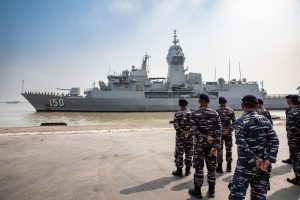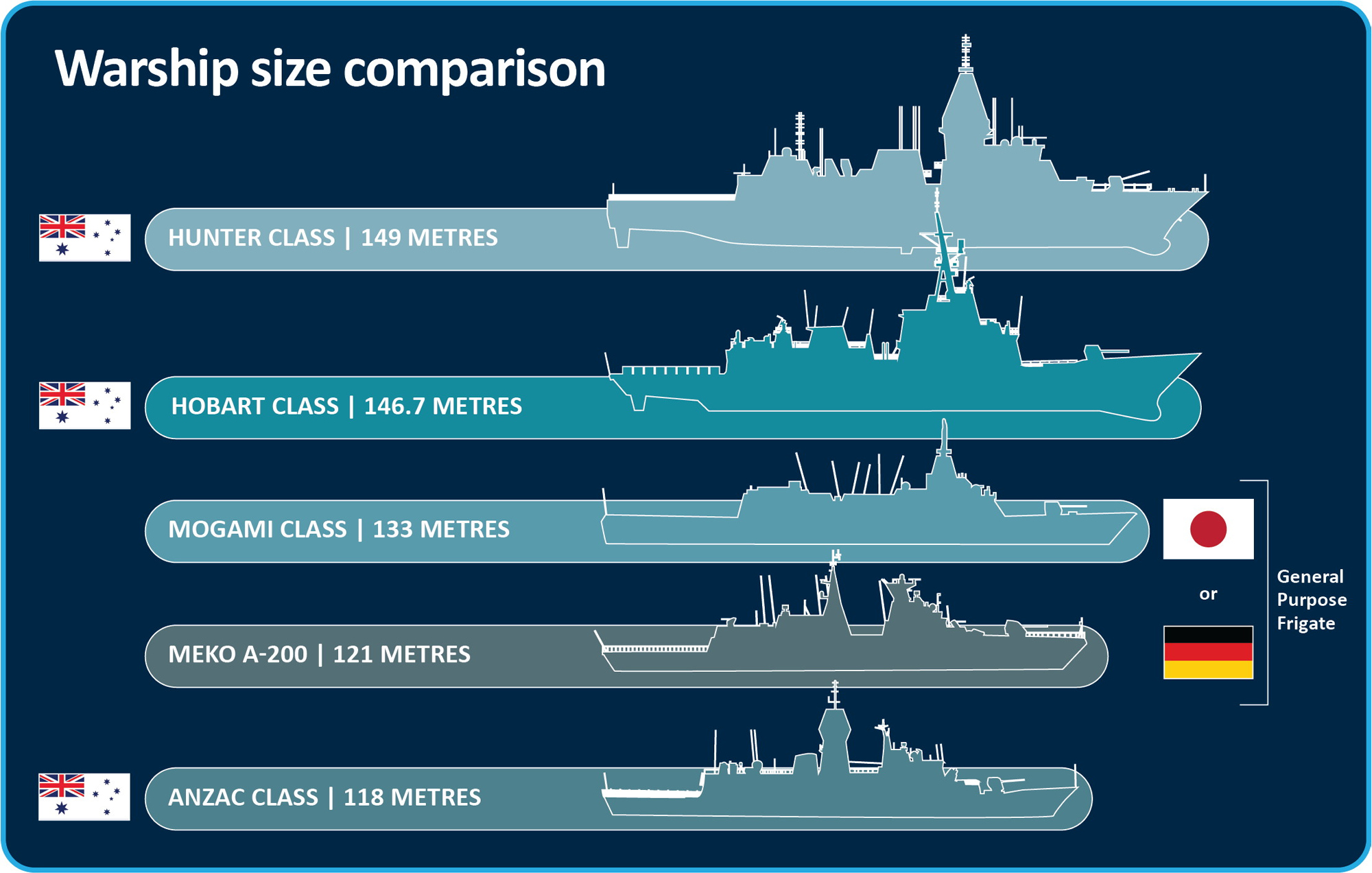The Australian government has shortlisted Japan’s Mitsubishi Heavy Industries (MHI) and Germany’s Thyssenkrupp Marine Systems (TKMS) over Spanish and South Korean contenders to build the Royal Australian Navy (RAN)’s future general purpose frigates.
The Australian Department of Defence (DoD) on November 25 said in selecting a winner for the 10 billion Australian dollars (US$6.5 billion) project, it will now work with the two shipbuilders and Australian industry partners to further develop the proposals for their respective ship designs. MHI is pitching the upgraded Mogami-class frigate to the Albanese government, meanwhile, TKMS has offered its MEKO A-200 design.
Under the decade-long general purpose frigate program known as Project Sea 3000, the Australian government plans to ensure the RAN “is equipped with a larger and more lethal surface combatant fleet to respond to our strategic circumstances,” the DoD said in a statement.
Australia’s new general purpose frigates “will be equipped for undersea warfare and local air defense in order to secure maritime trade routes and our northern approaches,” it added.
Australia plans to acquire 11 new general purpose frigates to complement the country’s combat-ready fleet of warships by replacing the eight aging Anzac-class frigates commissioned in the 1990s and early 2000s.
The first three ships will be built offshore, with the first to be delivered to the RAN in 2029 and enter service in 2030. The remaining eight will be built at Henderson shipyard in Western Australia.
Japan regards Australia as its second most important “quasi-ally” in terms of security after its only formal ally, the United States. And as the military threat from China rapidly increases in the Indo-Pacific region, Japan and Australia have moved closer than ever before. Tokyo is striving to make the Mogami-class export a success and further strengthen the bilateral relationship.
On November 28, the Japanese government announced that it has decided to allow joint development and production, if the upgraded Mogami-class is selected as Australia’s new frigate. The decision came after it held a National Security Council meeting and deliberated based on its three principles for the transfer of defense equipment and technology.
“This joint development and production project will contribute to significantly improving interoperability and compatibility with Australia, strengthen the shipbuilding and maintenance base in the Indo-Pacific region, and improve the future capabilities of Japan’s ships, and is of great significance to Japan’s security,” the Japanese government said in a statement.
If this is realized, it will be the first defense equipment transfer case involving a Japan Maritime Self-Defense Force (JMSDF) ship.
The Mogami-class frigate, also known as 30FFM, is the JMSDF’s stealthy multi-mission frigate, intended for surveillance missions in waters surrounding the Japanese archipelago. It is equipped with enhanced multirole capabilities, including the ability to conduct anti-mine warfare operations.
Most notably, the Mogami-class only needs about 90 crew members, which is about half the crew complement of destroyer-type vessels such as the Asahi-class.
In contrast, Australia’s existing Anzac-class requires about 180 personnel.
The Australian government is giving two shipbuilders the opportunity to propose modifications to their off-the-shelf designs.
Japan is bidding with the upgraded Mogami-class with a standard displacement of 4800 tons.
“’Upgraded Mogami’ is superior in low signatures design, high speed(30+kt), automation and low manning (approx.90), improved air defense capability and survivability, reduced lifecycle cost, mine hunting capability etc.,” according to one Japanese MoD document presented at the Maritime/Air/Space Technologies (MAST) Australia 2024 event held on November 19-21 in Adelaide.
The JMSDF plans to build a total of 12 Mogami-class frigates until the fiscal year 2023, with plans to acquire a new class of 12 FFMs from 2024 until 2028.
This new class frigate will essentially be improved Mogami-class ships. The Japanese defense ministry said the new-class FFM will be fitted with longer-range missiles, enhanced anti-submarine capabilities, and improved capabilities for various maritime operations.
Specifically, the ship-launched, improved version of the Type 12 SSM and the new ship-to-air guided missile (or simply A-SAM) will be equipped with the new-class FFM, defense officials said.
With better anti-aircraft and search capabilities, the new FFM may become closer to the FFG (missile frigate).
On the other hand, there is a strong view that the German MEKO A-200 has the advantage. The class has been exported to three countries: South Africa, Algeria, and Egypt.
“The German MEKO design is a bigger and more modern version of the Anzacs and is seen as the lower-risk choice because of this familiarity, as well as TKMS’ experience as an exporter,” the Australian Financial Review reported on November 7.
“Mitsubishi’s Mogami design is favoured by some on strategic grounds, as a way of binding together the Japanese and Australian navies at a time of increasing concern over China’s rapid military build-up. However, Japan has a lack of an export culture around selling ships to foreign navies,” the article pointed out.
Will Australia strategically choose the upgraded Mogami-class to strengthen bilateral cooperation in the face of the growing threat that China poses to the Indo-Pacific region? Or will it opt for the German-designed frigate that is familiar to — and compatible with — the existing Royal Australian Navy? Great attention is focused on the Australian government’s final decision scheduled for 2025.


































